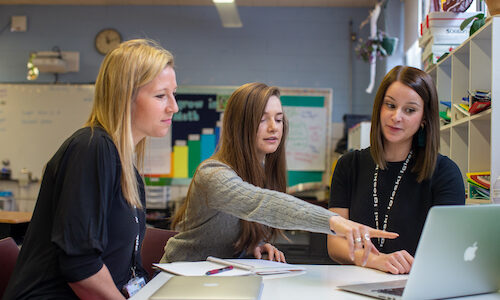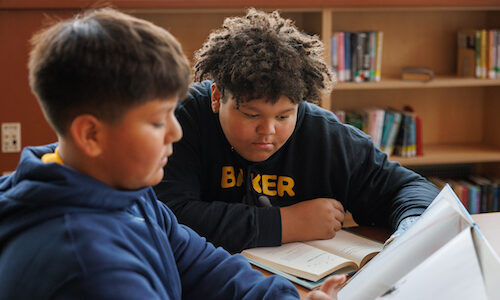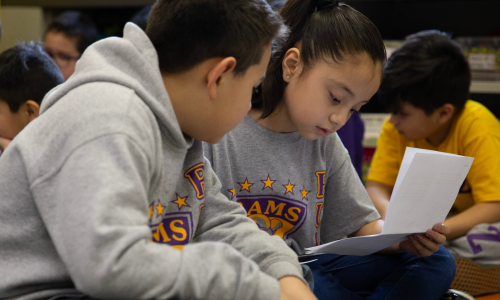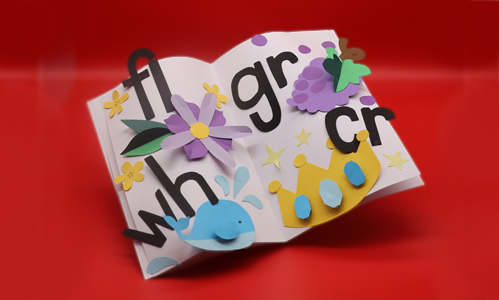 Whether you are in your third or thirtieth year in education, one thing is for sure: differentiation in the classroom is non-negotiable. School leaders expect teachers to use all the resources at their disposal— their curriculum, assessments, and professional learning—to provide an optimal learning experience for their students. Leaders expect diverse levels of support, a dynamic classroom configuration, and layers of reflection and development to push learning forward and meet desired outcomes. Differentiation, just like data, is now part of our collective, universal classroom day-to-day.
Whether you are in your third or thirtieth year in education, one thing is for sure: differentiation in the classroom is non-negotiable. School leaders expect teachers to use all the resources at their disposal— their curriculum, assessments, and professional learning—to provide an optimal learning experience for their students. Leaders expect diverse levels of support, a dynamic classroom configuration, and layers of reflection and development to push learning forward and meet desired outcomes. Differentiation, just like data, is now part of our collective, universal classroom day-to-day.
But rarely is that best practice—differentiation—one we emphasize, scrutinize, and implement when selecting professional learning opportunities for our teachers. Many school leaders expect our teachers to provide a bespoke, custom learning experience to meet the needs of their diverse learners, but with teachers, learning is often one size fits all. And we know that way simply doesn’t make an impact.
Borrow from what works in the classroom
For our students, differentiation often starts with assessment data. Whether it is MAP® Growth™ assessment data, formative assessment data, or graded quizzes and end-of-unit tests, assessment in all its forms serves to provide insight into where our students are in their learning and if they are making progress. From there, classroom teachers rely on their full arsenal of resources to provide a learning experience for each student that is as personal and meaningful as possible. I refer to this frequently as differentiation non-negotiables. Differentiation requires a complete understanding of students, content, and data; that’s what’s required to bring differentiated learning to life.
It may seem obvious, but classroom teachers should also have an interest in their students. They should understand their data but also who they are as individuals. All of that context helps teachers plan accordingly, so students stay engaged and feel ownership of their learning. That bit of cultural capital goes a long way when creating flexible groups, which is the perfect entry-level differentiation practice for teachers who are wondering where to start. For our students, agency grounded in their interests creates trust, supports collaboration in working toward goals, and fortifies a classroom culture.
Instead of a one-size-fits-all approach, school leadership should similarly try to better understand the professional goals of their teachers and maybe even their learning styles as individuals and what they find meaningful in their professional practice. Years of experience also make a difference in what a teacher finds meaningful. A veteran teacher’s needs are almost always different from those of a teacher new to the classroom. By differentiating professional learning, we use cherished funds carefully and with intention, and our teachers benefit from a tailormade learning experience. Just like kids do.
Tips for differentiating teacher professional learning
How can you differentiate professional learning for your teachers? I believe the following can help:
- Aim for a thorough understanding of your school’s data. Reports such as the MAP Growth School Profile report provide a high-level overview of both grade- and classroom-level data in your school. This can help you identify school-wide areas of strength and areas of focus, as well as home in on grades or specific classes and populations within a grade.
- Familiarize yourself with the standards to be taught. Being up to date on statewide learning expectations, cut scores, and large learning standards for each grade can help you better understand the work your teachers have before them.
- Work toward an authentic understanding of your faculty. The same way teachers are encouraged to know who their students are—their strengths, interests, and goals—I encourage you to get to know who is in your building. Having routine goal-setting conversations as well as general life check-ins with faculty will give you valuable insight into the personas you have in your school. With that knowledge, it can be easier to prioritize learning experiences for your teachers that align with their goals and interests.
Start now
Here’s my challenge to you, fearless school leaders! Instead of sending your teachers out of the building to attend learning that may or may not improve their instruction, try tailoring their experiences by selecting the most meaningful professional learning opportunities for them. I was sent to every (and I mean every) professional learning opportunity as a teacher. While some of those experiences were helpful, others were simply not aligned to my needs. I tried my best to implement what I learned in my classroom, but my most beneficial professional learning was always specific to my goals and immediately actionable.
To learn more about professional learning opportunities available through NWEA, visit our website. We offer workshops on using MAP Growth data, literacy instruction, creating supportive learning environments, and more.






